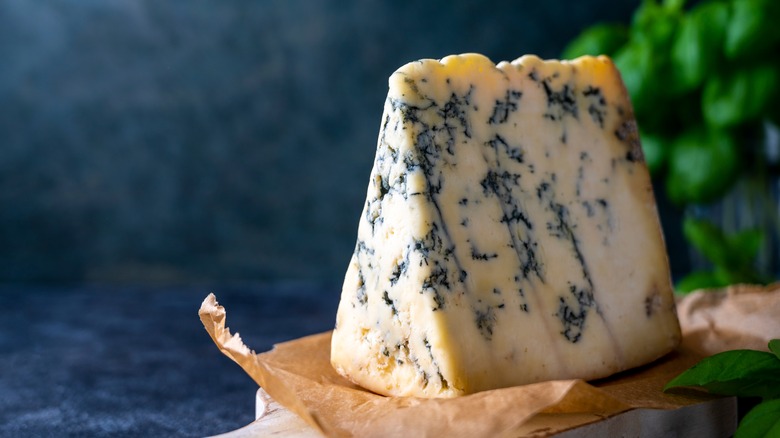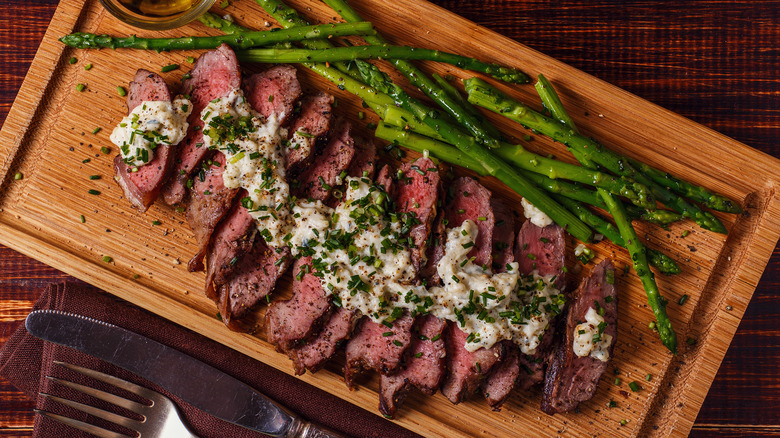The Funky Cheese Bobby Flay Tops His Steaks With
Few people know their way around a steak like Bobby Flay does. Since the world-renowned chef began hosting his first grilling show on the Food Network in 1996, he has dedicated a good chunk of his career to delivering straightforward tips that guarantee juicy steaks every time. While most of his fans know him for his fairly simple, traditional recipes, Flay does like to experiment with bold flavors. In fact, one of his most unique pairings for steak might just be blue cheese.
While the mold strains in these cheeses are indeed safe to eat, some just can't get behind their pungent flavor and strong aroma — but Flay believes it truly goes great with a beefy steak. The creamy cheese, with its deep savory notes, makes a fatty cut like ribeye even richer, while also balancing out the meat with some sharpness. You also don't need a ton of the cheese, in case you want to start off slow.
Sometimes, Flay likes to mix blue cheese with some butter and thyme to create a creamy, savory spread, which he then dollops directly onto a steak after plating. Other times, he simply garnishes the beef with a crumble of cheese and drenches it in leftover browned butter from his skillet. The chef likes to add this ingredient to both grilled and pan-seared steaks, so don't feel afraid to try it with your favorite recipe.
Pick the right kind of blue cheese for your steak
Not all blue cheeses will affect the flavor of your food in the exact same way. Some styles of this funky ingredient, such as Roquefort, feature a brittle, feta-like consistency. On the other hand, variants like Cambozola have a softer, buttery texture. The term "blue cheese" actually refers to a large number of cheeses that vary in taste, feel, and even appearance.
In the context of Bobby Flay's steak recipes, this means that you'll need to select the variant that best matches the texture of the dish's garnish. For example, a creamy Stilton can pair excellently with the thyme butter spread the professional chef uses for grilled filet mignon, but a crumbly Maytag might just result in a lumpy dressing. Meanwhile, you're likely going to have a hard time trying to grate the smooth Gorgonzola into sliced steak, as its texture is just not dry enough.
You should also keep in mind the intensity of your blue cheese — especially if you're serving it to a large crowd of people. Variants like Maytag have potent smells and flavors that can turn off a lot of appetites, so you might want to select a milder kind (such as Danish Blue) to accommodate certain guests. In most cases, cheeses with lots of blue marbling or powerful smells typically have a more pungent taste. There are exceptions, so sample a few to see which fits your needs the best.
Other steak garnishes and tips from Bobby Flay
Blue cheeses aren't the only unusual ingredient Bobby Flay likes to add to his beef. For New York strip steak, the famous chef creates a mint-horseradish dressing, which adds a cool, spicy kick to the meat. For even stronger heat, he has also drenched skirt cuts with a jalapeño pesto sauce — a peppery twist on the classic Italian condiment. If you prefer something a bit sweeter, Flay likes to reach for gochujang as a steak glaze. All these sauces are enough to mix up the flavor of a filet mignon on their own, but you're also welcome to add some blue cheese crumbles if you'd like to introduce more complexity to your food.
If you want an even more flavorful steak, Flay always tells home cooks to never hold back on the temperature. High heat ensures that your beef cuts achieve that crunchy exterior that most people yearn for, and delivers nice textural contrast to the overall dish. Flay also admitted that he prefers his meat cooked medium due to the resulting juiciness, so keep that in mind next time you follow his blue cheese steak recipe.



